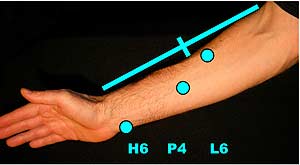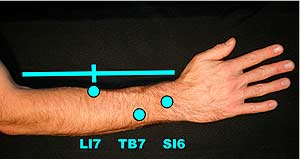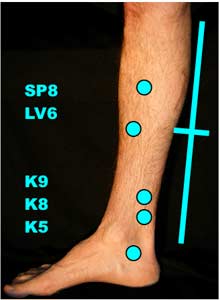Pain Relief Pressure Points For Martial Artists
By David Bock C.Ac. Dipl.OM. FABORM
Acupuncturists use many points on the body. The large number of useful points can seem overwhelming. To simplify, Acupuncturists generally classify points into categories. Understanding the functional properties of the points in a category helps the acupuncturist select which point is needed for a given situation. There is one group of points that I feel martial artists should become familiar with. They are not strike points that will suddenly freeze an opponent or make him drop dead. They are however some of the best points for relieving pain, particularly acute pain in the hands, feet, knees and shoulders.
These points are called Xi Xue (shee shw eh), often referred to as Xi Cleft (shee kleft) points. The xi cleft points regulate and relieve “excess” pain in its related channel. Lets say you smash your index finger in a strike, and the finger is tender to the touch. The Lung channel ends in the index finger. Rubbing the Lung channel xi cleft point can relieve this pain. These xi cleft points are not as helpful when it comes to old injuries, marked by dull aches. Excess pain is defined as a pain that gets worse with movement and pressure to the location, usually, this means recent trauma. I find that the best thing is to rub the appropriate point vigorously until the pain is dispersed, and repeat as needed. There are technically 16 xi cleft points, one for each of the main acupuncture channels including some of the extra channels.
On a practical level, it is unlikely for a martial artist who is in pain, to figure out which particular point is needed, and exactly where it is. There are two strategies for using these points effectively. If you know that you tend to injure a particular joint due to the type of training you do, it would be a good idea to figure out which are the most useful points for you, based on the types of injuries you regularly sustain. Simply check out an acupuncture chart and find the xi cleft point on the channel that goes to the area where you tend to have pain.
For everyone else, there is a quick trick to this. If you look at the forearm and lower leg, you can imagine the muscles forming a hill in the middle, with steep sides near the elbows and knees and long flat lands closer to the wrist and ankles. Many of the most useful xi cleft points are on the gradual slope between the flat lands and the high point of the hill. Many of the rest are on the flat area close to the wrists and ankles. For example, if you have an injury say to your big toe, stretch the foot out and the xi cleft point is in the area where the line of the big toe crosses the area from the ankle to the high point of the hill of the muscle. Rub that whole area along that line and you will invariably rub a helpful xi cleft point. When in doubt just rub the whole mid part of the limb from the start of the muscle near the wrist and ankles to the mid point of the muscles.
The xi cleft points are listed below in standard notation that can be found on any acupuncture point diagram.
To get detailed location information, check out the xi cleft points at:
http://acupuncture.com/education/points/index.htm
Xi Cleft points, area of influence and common language location description:
Heart H6, (small finger, medial elbow) With hand palm up, the point is on the line formed by the small finger. The point is on the arm, ½ a thumb width from the wrist crease. Fig.1
Pericardium P4, (palm of hand, middle finger) With palm up, the point is on a line down the center of the fore arm, one thumbs width closer to the wrist from the midpoint of the forearm. Fig.1
Lung L6, (index finger, forearm) When the arm is laying palm up, the point is on a line from the edge of the wrist crease at the base of the thumb to the outer edge of the elbow crease, one thumb width closer to the elbow, from the midpoint of that line. Fig.1
 Figure 1 Figure 1
Large Intestine LI 7, (thumb, lateral elbow) When the hand is set on edge, thumb up, the point is at the midpoint of a line connecting the space between the tendons at the base of the thumb and radius bone and the lateral end of the line of the elbow crease. Fig.2
Triple Burner (San Jiao) TB7, (ring finger, upper arms) With palm down, draw a line down the center of the back of the forearm, the point is just off the line, to the small finger side of the arm, three thumb widths from the wrist line. Fig.2
Small Intestine SI6, (small finger, point of elbow) With palm facing the chest, the point is between the radius and ulna bones of the arm, just above the “bump” of the ulna on the back of the wrist. Fig.2
 Figure 2 Figure 2
Spleen Sp8, (big toe, medial knee) About a hands width below the crease line of the knee, directly above the medial ankle bone. ( 3 thumb widths below the medical condyle of the tibia). Fig.3
Liver LV6, (big and second toe, anterior knee) On a line from the center of the medial anklebone, one thumbs width closer to the ankle, from the midpoint of the lower leg. Fig.3
Yin wei-linking K9, (anterior foot, knee and leg) Five thumb widths above the point in the space between the medial ankle bone and the Achilles tendon. Fig.3
Yin qiao heel K8 (flexion ability of the foot) Two thumb widths above the point in the space between the medial anklebone and the achilles tendon. Fig.3
Kidney K5, (medial ankle, ball of foot) Located above the medial side of the heel, one thumb width below the center of the space between the medial ankle bone and Achilles tendon. (superior to the tuberosity of the navicular bone). Fig.3
 Figure 3 Figure 3
Gallbladder G36, (lateral ankle, lateral knee, blade of foot) On the line directly above the back edge of the lateral anklebone, one thumbs width closer to the ankle from the mid point of the lower leg. (Next to G35) Fig.4
Yang wei-linking G35, (muscles of lower leg) Directly above the center of the lateral anklebone, one thumbs width closer to the ankle, from the midpoint of the lower leg. (Next to G36) Fig.4
Yang qiao heel B59, (lateral ankle) Three thumbs width directly above the point between the center of the lateral ankle bone and the Achilles tendon. Fig.4
Bladder B63, (heel, small toe, blade of foot) On the blade (small toe side of foot) in the notch directly below the front edge of the ankle bone.( depression on lateral aspect of the cuboid bone). Fig.4
 Figure 4 Figure 4
Stomach ST34, (center line top of foot to middle toes, center of knee) Located two thumb widths superior to the lateral edge of the knee cap. Trick; circle your right thumb and forefinger (index finger) around the bottom of the left knee cap, pointing the tip of the fore finger to your hip. The tip of the forefinger should land on the point (use left hand on the right knee). Fig.5
 Figure 5 Figure 5
About The Author:
David Bock, C.Ac. Dipl.Ac. Dipl.CH, is a teacher of Wadokai Aikido (under Roy Suenaka Sensei), a Wisconsin Certified Acupuncturist, NCCAOM National Board Certified in Acupuncture and Chinese Herbology, author of the online column “The Practical Herbalist” at www.lakecountryonline.com. He can be reached at www.hartlandorientalmed.com. David is a regular contributor to www.FightingArts,com. |